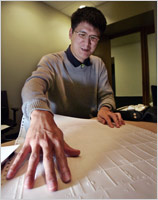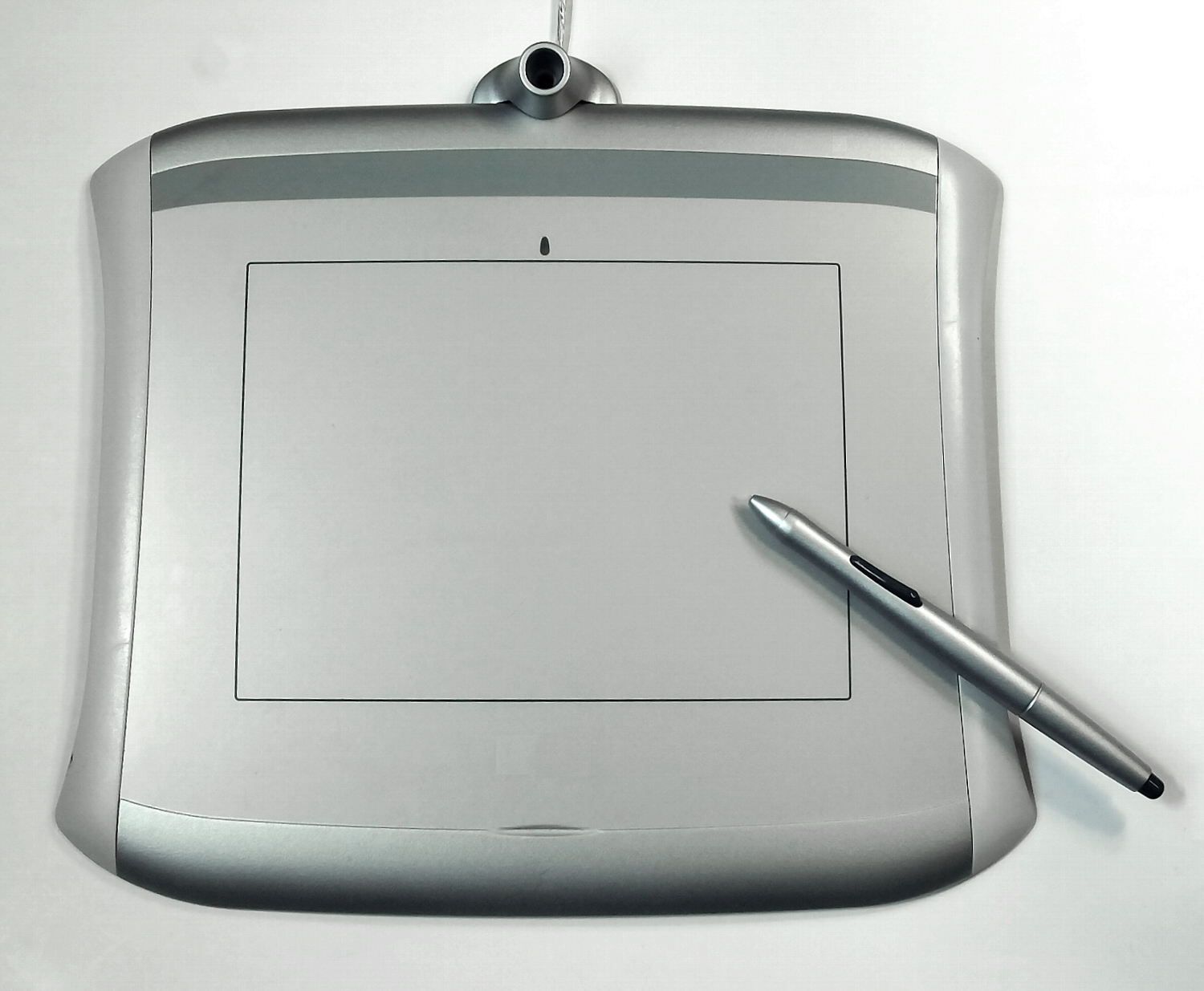|
Tactile Graphic
Tactile graphics, including tactile pictures, tactile diagrams, tactile maps, and tactile graphs, are images that use raised surfaces so that a visually impaired person can feel them. They are used to convey non-textual information such as maps, paintings, graphs and diagrams. Tactile graphics can be seen as a subset of accessible images. Images can be made accessible to the visually impaired in various ways, such as verbal description, sound, or haptic (tactual) feedback. One of the most common uses for tactile graphics is the production of tactile maps. Tactile maps The types and forms of tactile maps began with the oldest and most rudimentary or a mixed media format. This tactile map is produced by simply attaching objects to a substrate to represent different items or symbols. More recent tactile maps are produced by computers through different means such as an ink-jet printers. Thermoform is one of the most common methods of producing tactile maps. This process is also know ... [...More Info...] [...Related Items...] OR: [Wikipedia] [Google] [Baidu] |
Visual Impairment
Visual impairment, also known as vision impairment, is a medical definition primarily measured based on an individual's better eye visual acuity; in the absence of treatment such as correctable eyewear, assistive devices, and medical treatment– visual impairment may cause the individual difficulties with normal daily tasks including reading and walking. Low vision is a functional definition of visual impairment that is chronic, uncorrectable with treatment or correctable lenses, and impacts daily living. As such low vision can be used as a disability metric and varies based on an individual's experience, environmental demands, accommodations, and access to services. The American Academy of Ophthalmology defines visual impairment as the best-corrected visual acuity of less than 20/40 in the better eye, and the World Health Organization defines it as a presenting acuity of less than 6/12 in the better eye. The term blindness is used for complete or nearly complete vision loss. In ... [...More Info...] [...Related Items...] OR: [Wikipedia] [Google] [Baidu] |
Accessible Image
Accessibility is the design of products, devices, services, vehicles, or environments so as to be usable by people with disabilities. The concept of accessible design and practice of accessible development ensures both "direct access" (i.e. unassisted) and "indirect access" meaning compatibility with a person's assistive technology (for example, computer screen readers). Accessibility can be viewed as the "ability to access" and benefit from some system or entity. The concept focuses on enabling access for people with disabilities, or enabling access through the use of assistive technology; however, research and development in accessibility brings benefits to everyone. Accessibility is not to be confused with usability, which is the extent to which a product (such as a device, service, or environment) can be used by specified users to achieve specified goals with effectiveness, efficiency, convenience, or satisfaction in a specified context of use. Accessibility is a ... [...More Info...] [...Related Items...] OR: [Wikipedia] [Google] [Baidu] |
Haptic Perception
Haptic perception ( gr, haptόs, script=latn, italics=yes "palpable", ''haptikόs'' "suitable for touch") means literally the ability "to grasp something". Perception in this case is achieved through the active exploration of surfaces and objects by a moving subject, as opposed to passive contact by a static subject during ''tactile perception''.Weber, E. H. (1851). ''Die Lehre vom Tastsinne und Gemeingefühle auf Versuche gegründet''. Friedrich Vieweg und Sohn. History The term ''haptik'' was coined by the German Psychologist Max Dessoir in 1892, when suggesting a name for academic research into the sense of touch in the style of that in "acoustics" and "optics". Gibson (1966) defined the haptic system as " e sensibility of the individual to the world adjacent to his body by use of his body". Gibson and others further emphasized what Weber had realized in 1851: the close link between haptic perception and body movement, and that haptic perception is active exploration. The co ... [...More Info...] [...Related Items...] OR: [Wikipedia] [Google] [Baidu] |
Vacuum Forming
Vacuum forming is a simplified version of thermoforming, where a sheet of plastic (in various forms HIPS (High impact polystyrene) for low impact products, or for Bathroom shower trays ABS, and exterior vehicle parts HDPE, plus various other types of vacuum formable materials) is heated to a forming temperature, stretched onto a single-surface mould, and forced against the mould by a vacuum. This process can be used to form plastic into permanent objects such as turnpike signs and protective covers. Normally draft angles are present in the design of the mould (a recommended minimum of 3°) to ease removal of the formed plastic part from the mould. Relatively deep parts can be formed if the formable sheet is mechanically or pneumatically stretched prior to bringing it into contact with the mold surface and applying the vacuum. Suitable materials for use in vacuum forming are conventionally thermoplastics. The most common and easiest to use thermoplastic is ''high impact polys ... [...More Info...] [...Related Items...] OR: [Wikipedia] [Google] [Baidu] |
Braille Embosser
A braille embosser is an impact printer that renders text as tactile braille cells. Using braille translation software, a document or digital text can be embossed with relative ease. This makes braille production efficient and cost-effective. Braille translation software may be free and open-sourced or paid. Blind users tend to call other printers "ink printers," to distinguish them from their braille counterparts. This is often the case regardless of the type of printer being discussed (e.g., thermal printers being called "ink printers" even though they use no ink). As with ink printers and presses, embossers range from those intended for consumers to those used by large publishers. The price of embossers increase with the volume of braille it produces . Types The fastest industrial braille embosser is probably the $92,000 Belgian-made NV Interpoint 55, first produced in 1991, which uses a separate air compressor to drive the embossing head and can output up to 800 brail ... [...More Info...] [...Related Items...] OR: [Wikipedia] [Google] [Baidu] |
Substrate (printing)
Substrate is used in a converting process such as printing or coating to generally describe the base material onto which, e.g. images, will be printed. Base materials may include: * plastic films or foils, * release liner * textiles, * plastic containers * any variety of paper (lightweight, heavyweight, coated, uncoated, paperboard, cardboard, etc.), or * parchment. Electronics Printing processes such as silk-screening and photolithography are used in electronics to produce printed circuit boards and integrated circuits. Some common substrates used are;Rogers & Plett, p. 162 * Glass-reinforced epoxy, eg FR-4 board * Ceramic-PTFE laminate, eg 6010 board * Alumina ceramic * Silicon * Gallium arsenide * Sapphire * Quartz Quartz is a hard, crystalline mineral composed of silica (silicon dioxide). The atoms are linked in a continuous framework of SiO4 silicon-oxygen tetrahedra, with each oxygen being shared between two tetrahedra, giving an overall chemical form ... Referen ... [...More Info...] [...Related Items...] OR: [Wikipedia] [Google] [Baidu] |
Jacques Bertin
Jacques Bertin (27 July 1918 – 3 May 2010) was a French cartographer and theorist, known from his book ''Semiologie Graphique'' (''Semiology of Graphics''), published in 1967. This monumental work, based on his experience as a cartographer and geographer, represents the first and widest intent to provide a theoretical foundation to Information Visualization,Juan C. Dürsteler (2000-08)Interview with Jacques Bertin Retrieved 23 June 2008. with his most lasting contribution being his set of visual variables that can be used to construct map symbols and other graphical techniques one of then being the Bertin Projection, an innovative map projection type. Biography Jacques Bertin was born in 1918 in Maisons-Laffitte, Yvelines. When he was 10, he received the first prize of cartography at primary school. He never had problems with drawing, and pursued interests including architecture, the teaching of drawing and cartography. Finally he ended up studying geography and cartography ... [...More Info...] [...Related Items...] OR: [Wikipedia] [Google] [Baidu] |
Graphic Tablet
A graphics tablet (also known as a digitizer, digital graphic tablet, pen tablet, drawing tablet, external drawing pad or digital art board) is a computer input device that enables a user to hand-draw images, animations and graphics, with a special pen-like stylus, similar to the way a person draws images with a pencil and paper. These tablets may also be used to capture data or handwritten signatures. It can also be used to trace an image from a piece of paper that is taped or otherwise secured to the tablet surface. Capturing data in this way, by tracing or entering the corners of linear polylines or shapes, is called digitizing. The device consists of a rough surface upon which the user may "draw" or trace an image using the attached stylus, a pen-like drawing apparatus. The image is shown on the computer monitor, though some graphic tablets now also incorporate an LCD screen for more realistic or natural experience and usability. Some tablets are intended as a replacemen ... [...More Info...] [...Related Items...] OR: [Wikipedia] [Google] [Baidu] |
Adobe Flash
Adobe Flash (formerly Macromedia Flash and FutureSplash) is a multimedia Computing platform, software platform used for production of Flash animation, animations, rich web applications, application software, desktop applications, mobile apps, mobile games, and embedded web browser video players. Flash displays text, vector graphics, and raster graphics to provide animations, video games, and applications. It allows streaming of Flash Video, audio and video, and can capture mouse, keyboard, microphone, and camera input. Digital art, Artists may produce Flash graphics and animations using Adobe Animate (formerly known as Adobe Flash Professional). Programmer, Software developers may produce applications and video games using Adobe Flash Builder, FlashDevelop, Flash Catalyst, or any text editor combined with the Apache Flex SDK. End users view Flash content via Adobe Flash Player, Flash Player (for web browsers), Adobe AIR (for desktop or mobile apps), or third-party players such as ... [...More Info...] [...Related Items...] OR: [Wikipedia] [Google] [Baidu] |
Raster
Raster may refer to: * Raster graphics, graphical techniques using arrays of pixel values * Raster graphics editor, a computer program * Raster scan, the pattern of image readout, transmission, storage, and reconstruction in television and computer images * Rasterisation, or rasterization, conversion of a vector image to a raster image * Raster image processor, or RIP, a component of a printing system that performs rasterisation * Raster interrupt, a computer interrupt signal * Raster to vector, an image conversion process * Raster bar, an effect used in computer demos * Raster-Noton, a record label * Rastrum, a device used in medieval music manuscripts to draw staff lines * Raster Document Object, a file format People * Christian Raster, statesman in Anhalt-Dessau * Hermann Raster Hermann Raster (May 6, 1827 – July 24, 1891) was an American editor, abolitionist, writer, and anti-temperance political boss who served as chief editor and part-owner of the ''Illinois Staats-Z ... [...More Info...] [...Related Items...] OR: [Wikipedia] [Google] [Baidu] |
Blindness Equipment
Visual impairment, also known as vision impairment, is a medical definition primarily measured based on an individual's better eye visual acuity; in the absence of treatment such as correctable eyewear, assistive devices, and medical treatment– visual impairment may cause the individual difficulties with normal daily tasks including reading and walking. Low vision is a functional definition of visual impairment that is chronic, uncorrectable with treatment or correctable lenses, and impacts daily living. As such low vision can be used as a disability metric and varies based on an individual's experience, environmental demands, accommodations, and access to services. The American Academy of Ophthalmology defines visual impairment as the best-corrected visual acuity of less than 20/40 in the better eye, and the World Health Organization defines it as a presenting acuity of less than 6/12 in the better eye. The term blindness is used for complete or nearly complete vision loss. In ... [...More Info...] [...Related Items...] OR: [Wikipedia] [Google] [Baidu] |







.jpg)